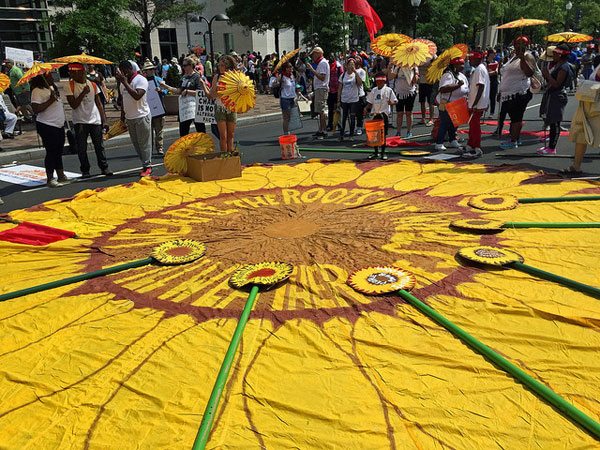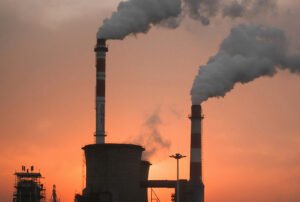
January 3, 2018; InsideClimate News
2017 was a hard year for groups defending environmental justice. Environmental justice is, according to the EPA, “the fair treatment and meaningful involvement of all people regardless of race, color, national origin, or income, with respect to the development, implementation, and enforcement of environmental laws, regulations, and policies.” This year’s setbacks include major changes to environmental regulations in favor of big business, thanks to the Trump administration’s prioritization of federal deregulation and eliminating Obama-era provisions, even as the movement showed its mettle in threatened locations like Standing Rock and in courtrooms and boardrooms across the country. The intensity of this moment in environmental justice isn’t likely to abate in 2018.
It has long been clear that people from marginalized and underserved communities are disproportionately impacted by climate change, drought, and pollution. A 1987 report, “Toxic Wastes and Race in the United States,” showed that race was “the single most important factor in determining where toxic waste facilities were sited in the United States.” This report and related activism led to the creation of the term “environmental justice,” which focuses on the crucial intersection between sustainability and equity. It is the struggle for a healthy and clean environment for everyone.
Robert Bullard, professor of urban planning and environmental policy and administration of justice at Texas Southern University, is often called the “father of environmental justice.” The author of 18 books on sustainable development and environmental racism, Bullard first became concerned with environmental justice in the late 1970s when he studied the positioning of garbage dumps in predominantly Black neighborhoods in Houston. That first investigation led to a lifetime of connecting the dots on issues involving housing, transportation, water quality, land use, and more. These issues all have the common denominator of people in positions of power (usually white) making decisions that negatively impact communities of color. These decisions include hosting toxic waste sites, garbage dumps, highways, and truck depots mostly in communities of color.
Referring to last year’s clear cutting of environmental protections, Bullard said, “There is a real war going on, and it’s a war against health, against the environment and against human rights. We are reverting to a pre-1970 era where anything goes.”
The Environmental Protection Agency (EPA) was established in 1970 in the wake of increased concern for the environment brought on in part by publication of Rachel Carson’s Silent Spring and multiple chemical fires on the polluted Cuyahoga River in Ohio. The EPA consolidated into one agency the federal research, monitoring, standard-setting, and enforcement activities that ensure environmental protection.
Sign up for our free newsletters
Subscribe to NPQ's newsletters to have our top stories delivered directly to your inbox.
By signing up, you agree to our privacy policy and terms of use, and to receive messages from NPQ and our partners.
However, Bullard’s prediction of reverting back to an era where “anything goes” seems more and more like a grim reality thanks to the relentless attacks by this administration that seems hell-bent on dismantling environmental protections in favor of big business.
The targets of these attacks are often those environmental protections viewed as overly burdensome to industry, especially the fossil fuel industry, which enjoys closer relationships with members of the Trump administration than President Obama’s. Since taking office in January 2017, the Trump administration has attempted to reverse at least 60 environmental rules, with 29 rules already overturned, 24 rollbacks in progress, and seven rule rollbacks in limbo so far. The latest came last week, when the Trump administration proposed lifting the ban on offshore drilling in nearly all US coastal waters. This is yet another blow to Obama’s environmental legacy, which had prohibited drilling on 94 percent of the outer continental shelf. These decisions will impact all communities, but the inevitable oil spills and other forms of degradation do not affect everyone equally.
The threats to environmental justice in 2017 were many, including the proposed budget calling for vast reductions in the EPA, which called for cutting the EPA’s staff by one fifth and closing dozens of programs, including completely dismantling of the EPA’s Office of Environmental Justice. Other notable losses include the demolition of the Oceti Sakowin protest camp in North Dakota and the granting of the final easement for the Dakota Access Pipeline. Particular pressing challenges include the situation of over 45 percent of Puerto Ricans who are still without power more than 100 days after Hurricane Maria hit and the ongoing ramifications of lead poisoning of water in Flint, Michigan.
There are, however, groups that are fighting back against last year’s assaults on environmental justice. Numerous lawsuits have been filed by conservation groups and outrage demonstrated by outdoor recreation companies. The Michigan Civil Rights Commission is among those working to address the historical and systemic racism at the center of environmental injustice. They recently published a hard-hitting report on the public health catastrophe in Flint. The report calls the crisis “a complete failure of government” and recommends implicit bias training for state officials.
While 2017 was fraught with dismaying assaults on the environment and people of color, it was also a year marked by rampant divestment from fossil fuels, resistance by groups including the Alt National Park Service and the I’m Still In movement which formed in response to the US’s proposed withdrawal from the Paris Accord, and more. No doubt, 2018 will present even more environmental justice challenges, but not without massive resistance by nonprofits and environmentally conscious companies that will continue to advocate on behalf of the planet and those most at risk from environmental hazards.— Mi Lovejoy













